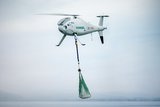GA‑ASI UAS academy graduates first pilots
The first cadre of aircrew have graduated from General Atomics Aeronautical Systems’ (GA‑ASI) UAS Flight Training Academy, it was announced on 25 August.
The North Dakota-based academy’s first graduating class included three pilots. Six sensor operators and five additional pilots will follow soon. The new aircrew will join GA-ASI’s 230-strong aircrew deployed worldwide for its Predator UAS series.
Prior to the academy opening, training occurred at the company’s California flight operations facilities, where aircrew instruction took as long as six months. Now, UAS training can be completed in two months. As part of the course, pilots complete 25 simulator lessons (59 hours), 15 flights (36 hours), and 114 hours of academic studies.
Before entering training, all GA-ASI UAS pilots must possess a FAA commercial instrument pilot rating, a Bachelor’s degree and accumulate 300 hours as a pilot-in-command. Sensor operators require a private pilot license or a commercial pilot rating. Both pilots and sensor operators also must be able to maintain a Class II FAA medical certificate and obtain and maintain a DoD security clearance.
The training academy's graduates are currently qualified for Predator A, but the company expects to make its Predator B training system available before the end of 2016. The academy can also augment the US Air Force's remote piloted aircraft training programmes.
Related Equipment in Defence Insight
More from Uncrewed Vehicles
-
Jammer resistant drone designs spark search for countermeasures
The Russia-Ukraine conflict has driven another stage of evolution for drones and the counter measures to defend against them.
-
![L3Harris launches Amorphous software for control of uncrewed platforms]()
L3Harris launches Amorphous software for control of uncrewed platforms
The new Amorphous software is a universal controller that would allow a single operator to control a swarm of “thousands” of uncrewed systems, from drones to underwater platforms.
-
ideaForge unveils new UAVs at Aero India 2025
India UAV supplier ideaForge has launched the Netra 5 and Switch V2 drones at Aero India 2025, boasting of enhanced endurance, AI-driven autonomy and improved operational capabilities.
-
![Shaping the future of defence: What 2025 holds for the global drone market]()
Shaping the future of defence: What 2025 holds for the global drone market
The UAV market is experiencing unprecedented growth, with innovations in technology and battlefield applications driving demand across military sectors. From the battlefields of Ukraine to NATO exercises and beyond, drones are transforming how wars are fought and supported.
-
![Maris-Tech confirms customers signing up for Jupiter Drones codec and AI-powered system]()
Maris-Tech confirms customers signing up for Jupiter Drones codec and AI-powered system
Launched at AUSA in October, the company’s multi-stream video codec is attempting to bring a new lease of life to drone technology through its AI accelerator.
-
![AUSA 2024: Quantum-Systems targets big 2025 with UAS developments]()
AUSA 2024: Quantum-Systems targets big 2025 with UAS developments
Quantum-Systems has been upgrading its UAS family, with new versions of the Vector, Reliant and Twister drones set for release throughout 2025.
























